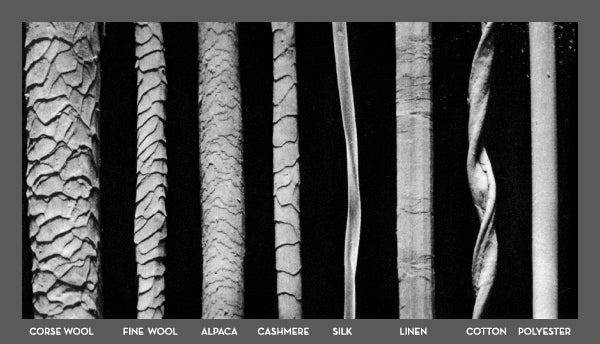Introduction:
In an era driven by innovation and convenience, synthetic apparel has ascended to prominence within the clothing industry. Its appeal lies in its affordability, durability, and a dazzling array of styles. However, while these fabrics adorn our bodies with vibrant colors and offer comfort, a darker truth lurks beneath their seemingly benign surface.

Amidst the allure of synthetic fabrics, the peril they pose to skin health remains an oft-overlooked concern. This blog ventures beyond the shimmering facade of synthetic apparel to illuminate the concealed hazards it presents to our skin. Delving into the fabric’s composition, chemical treatments, and implications for skin health, we uncover the detrimental impact synthetics have on our largest organ.
With a steadfast commitment to unraveling the truth, this blog serves as a clarion call to advocate for skin-friendly alternatives. Emphasizing the virtues of natural fabrics like merino wool, it champions a paradigm shift towards sustainable, skin-conscious choices in the apparel landscape.
Join us on this illuminating journey as we uncover the hidden perils of synthetic fabrics and champion the cause for healthier, eco-friendly options for our skin and the planet.
This extended introduction sets the stage for a deeper exploration into the hazardous effects of synthetic apparel on skin health while also teasing the discussion on the merits of alternatives like merino wool.
The Chemical Menace in Synthetic Apparel
The allure of synthetic fabrics often masks a concerning truth—their composition is rife with an arsenal of chemicals. Formaldehyde, phthalates, dyes, and an array of synthetic additives permeate these fabrics, setting the stage for potential skin distress. The prolonged interaction between these textiles and our skin initiates a perilous dance, one fraught with adverse consequences.

Formaldehyde, a common synthetic resin used in clothing, acts as a preservative but paradoxically becomes a skin irritant upon contact. Its inclusion in fabric production poses a considerable risk, inducing skin reactions ranging from mild irritation to severe allergic responses. Phthalates, employed to enhance flexibility and softness in synthetic materials, subtly seep into our skin, heightening the risk of allergic reactions and hormonal disruptions.
The vibrant hues of synthetic dyes belie their ominous potential. Laden with heavy metals and hazardous chemicals, these dyes can incite skin irritations and allergic reactions, compromising the skin’s natural barrier function. Beyond these immediate effects, prolonged exposure to these compounds might even contribute to more profound health issues, affecting overall well-being.
The cumulative impact of these toxic components on our skin should not be underestimated. Skin irritations, redness, rashes, and allergic reactions are common manifestations of the body’s response to these chemical intruders. In severe cases, these reactions can escalate, leading to chronic skin conditions that necessitate medical intervention.
This elaborated section provides a more detailed exploration of the specific chemicals found in synthetic fabrics and their potential adverse effects on skin health. It emphasizes the risks these chemicals pose, from minor irritations to severe allergic reactions and potential long-term health implications.
Microplastics: A Skin Invasion
The perils of synthetic fabrics extend beyond chemical components to the insidious infiltration of microplastics. These minute particles, imperceptible to the naked eye, form an ominous residue that poses significant threats to skin health. With each wear and wash, synthetic garments gradually release these minuscule plastic particles into the surrounding environment, creating an invisible cloud of potential hazards.

Once released, these microplastics make their way onto our skin, penetrating its superficial layers. Their diminutive size and stealthy infiltration into the skin’s microenvironment are unsettling. The repercussions of this invasion are manifold, exerting a disruptive influence on the skin’s delicate balance and natural functionality.
These intruding microplastics, despite their size, possess the potential to provoke a cascade of detrimental effects within the skin. They can trigger inflammation, disrupting the skin’s natural processes and compromising its ability to maintain equilibrium. Prolonged exposure to these infiltrators may incite persistent skin irritation, exacerbating existing conditions or potentially leading to the onset of new ones.
The long-term ramifications of these microplastics are a cause for concern. Chronic exposure may contribute to the escalation of skin health problems, fostering a landscape conducive to conditions like dermatitis, eczema, or other chronic skin ailments. The altered microenvironment created by these microplastics can even serve as a breeding ground for bacteria, compounding the risk of infections and dermal imbalances.
As the accumulation of these invisible adversaries disrupts the skin’s harmony, the consequences might extend beyond superficial irritations, permeating deeper layers and potentially posing significant challenges to long-term skin health.
This elaboration delves deeper into the repercussions of microplastics on skin health, emphasizing their potential to disrupt the skin’s natural functions, provoke inflammation, and create an environment conducive to chronic skin conditions and infections.
Embracing Skin-Friendly Alternatives
Embracing merino wool unveils a realm of skin-friendly benefits absent in synthetic counterparts. This natural fabric, harvested from merino sheep, stands apart as a champion of skin health. Unlike its synthetic adversaries, merino wool bypasses the use of toxic chemicals, offering an organic haven for the skin to thrive.

One of its most captivating attributes lies in its breathability, a fundamental quality that contributes significantly to its skin-friendly nature. The unique structure of merino wool fibers facilitates excellent airflow, allowing the skin to breathe effortlessly. This inherent breathability ensures optimal ventilation, preventing the accumulation of moisture and heat that can foster skin irritations.
Moreover, merino wool’s exceptional moisture-wicking prowess further enhances its skin-friendly credentials. The fibers possess a remarkable ability to pull moisture away from the skin’s surface, swiftly transporting it through the fabric. This efficient moisture management capability ensures that the skin remains dry and comfortable, minimizing the risk of irritations caused by dampness or sweat buildup.
Additionally, merino wool’s inherent resistance to bacteria serves as a shield against potential skin-related woes. Unlike synthetic materials, which can become breeding grounds for bacterial growth, merino wool naturally inhibits the proliferation of odor-causing bacteria. This unique property stems from the wool’s composition, creating an environment hostile to bacterial survival. Consequently, it not only keeps unpleasant odors at bay but also maintains a cleaner and healthier skin microenvironment.
The interplay of these inherent qualities - breathability, moisture-wicking abilities, and natural antibacterial properties - culminates in merino wool emerging as an ideal choice for those mindful of their skin’s well-being. This natural fabric offers a symbiotic relationship with the skin, prioritizing comfort, health, and a harmonious interaction that synthetic materials fail to replicate.
This expanded section emphasizes merino wool’s innate advantages for skin health, highlighting its breathability, moisture-wicking capabilities, and natural antibacterial properties as key contributors to its skin-friendly nature.
Upholding Skin Health and Sustainability
At Wool-e, our ethos pivots on an unwavering dedication to environmental stewardship and the uncompromising pursuit of optimal skin health. With a firm commitment to these principles, we proudly champion the virtues of merino wool as a cornerstone of our brand.

Central to our philosophy is the belief that apparel should seamlessly blend performance with sustainability while safeguarding the skin’s well-being. Synthetic materials have long dominated the market, yet their perils to both the environment and skin health remain undeniably significant. This realization fueled our mission to provide an alternative – one that champions both ecological responsibility and skin-friendly attributes: merino wool.
Merino wool embodies our values impeccably. It epitomizes sustainability through its renewable and biodegradable nature. Harvested from the fleece of merino sheep, this natural fabric stems from a cyclical process that respects the environment, from the grazing pastures to the shearing sheds.
Moreover, merino wool’s innate skin-friendly qualities align harmoniously with our dedication to optimal skin health. We advocate for a fabric that not only offers exceptional performance but also cares for the skin it adorns. Unlike synthetic counterparts laden with chemicals and microplastics, merino wool stands untainted, free from toxic components that might compromise skin integrity.
Our brand stands as a testament to the belief that environmental consciousness and skin health need not be mutually exclusive. Wool-e presents a curated selection of merino wool apparel that transcends fashion, embodying a commitment to sustainability and well-being. With every garment, we invite outdoor enthusiasts to embrace a lifestyle that harmonizes with nature, prioritizes skin health, and celebrates the unparalleled benefits of merino wool.
Conclusion
The prevalence of synthetic apparel in today’s market is undeniable, yet its potential detriments to skin health loom ominously. However, there exists a transformative choice – a conscious pivot towards natural alternatives like merino wool. Embracing this shift empowers individuals to safeguard their skin’s health without sacrificing style, comfort, or performance.

The unyielding march of synthetic fabrics has, in many ways, obscured the insidious effects they might have on our skin. However, this blog aimed to shed light on these overlooked perils, urging consumers to weigh the long-term implications of their clothing choices.
By opting for merino wool, individuals are presented with a paradigm shift – a departure from synthetic fabrics laden with chemicals and microplastics. Merino wool embodies an environmentally conscious, skin-friendly approach that resonates with those seeking a harmonious balance between personal well-being and ecological responsibility.
In essence, this shift represents an opportunity – a chance to redefine our relationship with the clothing we wear. It’s a call to embrace the natural, to revel in the comfort, performance, and ethicality offered by merino wool. Wool-e stands at the forefront of this movement, extending an invitation to individuals to embark on a journey that celebrates not just apparel but a lifestyle rooted in sustainability, skin health, and an appreciation for the undeniable allure of merino wool.
In the quest for a healthier, more conscientious tomorrow, the choice is clear – embrace merino wool, embrace a life that speaks volumes for skin health, environmental mindfulness, and uncompromised style.

